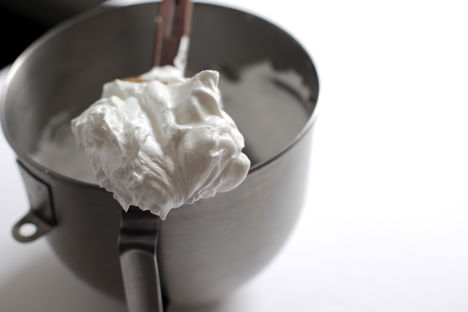Delicate, sweet and light, meringues are the perfect base for all sorts of desserts. The texture of meringue can vary greatly depending on personal preference; it can be hard and crunchy or be given a chewier finish. There are three key types of meringue that chefs tend to use, French, Swiss and Italian.
What is the most common meringue?
French meringue is the method most widely used by chefs and has a crisp exterior which makes it the ideal base for pavlova, roulades and filled vacherins. It is also the simplest to make, with only two ingredients, caster sugar and egg whites.
What amount of sugar to egg white for French meringue?
You want to work to a ratio of 50g of sugar for every egg white you use. For something like a pavlova meringue base, which serves about 6 people, you will need 4 egg whites and 200g caster sugar.
How to make meringue?
Whisk your egg whites and sugar to stiff peaks before piping out or spooning onto lined baking trays to bake. This method gives crisp, dry meringues, but if you wantmore chewy texture add a little cornflour and vinegar or lemon juice to achieve a mallowy middle. Follow our recipe for great results.
Are there any tricks or secrets to making the best meringue?
Use the freshest eggs you can find, as this will help them to separate more easily. When you’re ready to whisk, set it to a low speed and avoid beating the eggs too quickly to start with, as too furious whisking can break up the protein chains which will stop the whites from expanding and becoming pillowy. And avoid overwhisking as this will cause your egg white mixture to become lumpy and watery.
How do I stop my meringue from cracking?
It’s not always possible to avoid cracks in French meringue, but the key thing is to bake your meringues slowly and for a long time. If the oven is too hot air bubbles in the meringue will rise too quickly and cause cracks and holes to appear. To this end, it’s best to leave the cooked meringues to cool down completely in the oven with the door just slightly ajar, rather than shocking them into cracking at room temperature. If they are cooked and fully cooled they should come off the baking parchment easily, without any breakages.
What flavourings or toppings can I add to meringues?
French meringue mixture itself can be flavoured with dry ingredients such as cocoa powder, matcha tea powder, dried fruit powders, coffee and finely-ground nuts which can be added at the same time as the sugar. Once you have made your meringue nests or base, you can top it with anything you like, but a mix of something creamy and something fresh or a little tart always works well with the sweet chewy texture of the meringue. Try our idea for a kiwi pavlova:
Metric
Imperial
- 300ml of double cream
- 300g of lemon curd
- 1 tbsp of icing sugar
- 1 meringue nest, large
- 5 kiwi fruits, sliced
- 1 lime, zested
Whisk you double cream with 100g of lemon curd and the icing sugar until just holding its shape
- 300ml of double cream
- 300g of lemon curd
- 1 tbsp of icing sugar
Spread the remaining lemon curd over the meringue base, pile on the cream then top with slices of kiwi and some extra lime zest.
- 5 kiwi fruits, sliced
- 1 lime, zested
What is the difference between Swiss and Italian meringue?
Swiss meringue is made with sugar and egg whites which are whisked over a bain marie, which gently cooks the eggs and so creates a stable mixture and is used as the base for frosting and buttercream for icing cakes with. Make your own here
Italian meringue is made with hot sugar syrup whereby a little water is heated with the sugar, taking to what is known as the ‘soft ball’ stage. This is then poured into semi-whisked egg whites and whisked until cool. This meringue is the most stable of the meringues and has a soft consistency but holds its shape. Because of this it can be used straightaway for piping onto cakes and bases, topping lemon meringue pie and baked Alaska. Follow our method here for the Italian version:
Will meringue mixture keep in the fridge?
French meringue mixture is fairly unstable so it should be used as soon as it has been made or it will drop. Swiss and Italian meringue, however, are more stable so should hold their shape in the fridge for a time. They can be kept covered and chilled for up to 24 hours before using.
What can I make with meringue?
Baked French meringues are a treat on their own or try them bashed up in an Eton mess or Galton Blackiston’s version flavoured with coffee and served with passion fruit cream and summer fruits. Try making a Baked Alaska using Italian meringue as with Tom Aikens’ recipe or for something more challenging try Nathan Outlaw’s Sea buckthorn curd meringue with yoghurt sorbet and wholemeal shortbread.
Get in touch
Please sign in or register to send a comment to Great British Chefs.



